BP3000
- 格式:pps
- 大小:17.05 MB
- 文档页数:33
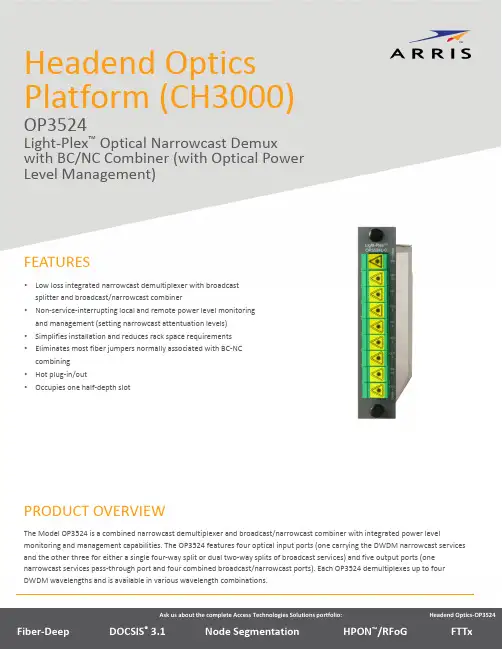
Headend Optics Platform (CH3000)OP3524Light ‐Plex ™Optical Narrowcast Demux with BC/NC Combiner (with Optical Power Level Management)The Model OP3524 is a combined narrowcast demultiplexer and broadcast/narrowcast combiner with integrated power levelmonitoring and management capabilities. The OP3524 features four optical input ports (one carrying the DWDM narrowcast services and the other three for either a single four ‐way split or dual two ‐way splits of broadcast services) and five output ports (one narrowcast services pass ‐through port and four combined broadcast/narrowcast ports). Each OP3524 demultiplexes up to four DWDM wavelengths and is available in various wavelength combinations.PRODUCT OVERVIEW•Low loss integrated narrowcast demultiplexer with broadcast splitter and broadcast/narrowcast combiner•Non ‐service ‐interrupting local and remote power level monitoring and management (setting narrowcast attentuation levels)•Simplifies installation and reduces rack space requirements •Eliminates most fiber jumpers normally associated with BC ‐NC combining •Hot plug ‐in/out•Occupies one half ‐depth slotFEATURESOne broadcast optical signal can be equally split four ways or each of two independent broadcast signals can be split two ways, while the narrowcast carriers are separated by a four channel ITU‐grid demultiplexer(on the 100 GHz‐spaced ITU grid). Each narrowcast optical carrier is then multiplexed with one of the common broadcast optical signals and passed to one of the four output ports. DWDM optical carriers whose wavelengths are not dropped by the demux are passed through to the DWDM output port.As new video and/or data carriers are added to the system, or as the configuration of the network is changed, the power levels of the optical carriers can change. To ensure optimal network performance, the optical power level management feature of theOP3524 allows power levels to be realigned remotely via SNMP interface to an element management system or locally via the chassis power supply display or local craft port interface. With the OP3524, broadband networks can be easily expanded by adding optical wavelengths without needing to break physical connections or install optical attenuators to realign the optical carrier power levels. By adding optical narrowcast carriers, the OP3524 allows MSOs to offer new, revenue generating services, such as digital video, video‐on‐demand, high‐speed data and telephony, more easily and cost‐effectively than ever before.RELATED PRODUCTSCH3000Chassis Optical Patch CordsOptical Transmitters Optical PassivesBP Back plates Installation ServicesSPECIFICATIONSCharacteristics SpecificationPhysicalDimensions7.3” D x 4.3” H x 1.0” W (3RU)(18.5 cm x 11 cm x 2.5 cm)Weight 1.5 lbs(0.68 kg)EnvironmentalOperating temperature range–20°to +65°C (–4°to 149°F)Storage temperature range–40°to +85°C (–40°to +185°F)Humidity5% to 95% non‐condensingOptical InterfaceOptical connectors SC/APCInputs DWDM INP (narrowcast content), BROADCAST A, B1, B2Outputs•DWDM OUT (pass‐through of all DWDM wavelengths not dropped)•#1, #2, #3, #4 (combined broadcast and one dropped DWDM NC)Power RequirementsInput voltage12 VDC (100 mA)Power consumption 1.2 WOpticalOptical return loss45 dB minPolarization Dependent Loss (PDL)0.25 dB maxDirectivity55 dB minBroadcast:Insertion loss (including connectors)•Broadcast Input Port A: 7.1 dB max (< 6.7 dB typ)•Broadcast Input Ports B1, B2: 4.2 dB max (< 3.7 dB typ)Uniformity (including connectors)0.6 dB max (< 0.4 dB typ)Passband At any given output port, the pass band for the BC signal transverses the entire C‐band (or EDFA gain band),excluding the NC wavelength to be dropped at that port.Wavelength Passthrough Only 1424.5–1617.5 nm input and outputDWDM Narrowcast:ITU channels dropped See ITU Channel PlansPassband @ 0.5 dB (centered on DWDM ITU grid)±0.11 nmRipple within passband0.5 dBInsertion loss (including connectors)•DWDM IN to #n OUT: 3.9 dB max (< 2.8 dB typ)•DWDM IN to DWDM OUT: 1.4 dB max (< 0.8 dB typ)Paired insertion loss (including connectors) 4.9 dB max (Paired insertion loss measured when combined with a single correspondent 4‐λ mux module,models OP35M4x‐x‐xx‐AS or BP35M4x‐0‐xx‐AS, Ch. yy INP to Ch. yy OUT)Optical channel isolation•Adjacent: 55 dB min (> 65 dB typ)•Non‐adjacent: 55 dB min (> 65 dB typ)Uniformity0.6 dB max (difference between max and min output power across the four output ports)Attenuation range12 dB minAttenuation control step size0.1 dBAttenuation control accuracy±0.25 dBOutput power stability0.15 dB p‐v (on 0‐12 dB attenuation range)GeneralHot plug‐in/outOptical input power range•Broadcast (A, B1 and B2): +3 to +22 dBm•Narrowcast: –6 to +17 dBm/ λ per wavelengthOptical output power range, max•Broadcast (A): –5 to +16 dBm•Broadcast (B1 and B2): –2 to +19 dBm•Narrowcast: –10 to +15 dBm/ λ per wavelengthITU Channel PlansARRIS supports DWDM network architectures with a variety of products on the standard DWDM ITU Grid(ITU‐T G.694.1). For more complete description of available DWDM ITU Grid channels and ARRIS’spartitioning into convenient logical channel groups for DWDM mux and demux applications, please refer tothe ARRIS DWDM ITU Grid Channel Plan data sheet.Note: Specifications are subject to change without notice.Copyright Statement: ©ARRIS Enterprises, LLC, 2016. All rights reserved. No part of this publication may be reproduced in any form or by any means or used to make any derivative work (such as translation, transformation, or adaptation) without written permission from ARRIS Enterprises, LLC (“ARRIS”). ARRIS reserves the right to revise this publication and to make changes in content from time to time without obligation on the part of ARRIS to provide notification of such revision or change. ARRIS and the ARRIS logo are registered trademarks of ARRIS Enterprises, LLC. Other trademarks and trade names may be used in this document to refer to either the entities claiming the marks or the names of their products. ARRIS disclaims proprietary interest in the marks and names of others. The capabilities, system requirements and/or compatibility with third ‐party products described herein are subject to change without notice.87‐10097‐RevJ_OP3524Customer CareContact Customer Care for product information and sales:•United States: 866‐36‐ARRIS •International: +1‐678‐473‐565603/2016ECO9660O P 3524*–0–00–A SOptical Narrowcast Demux with BC/NC/Combiner * = ITU Channel Plan Group: J, K, L, M, N, P, R, S, T, or U (Reserved Fields)AS = SC/APC ConnectorORDERING INFORMATION。
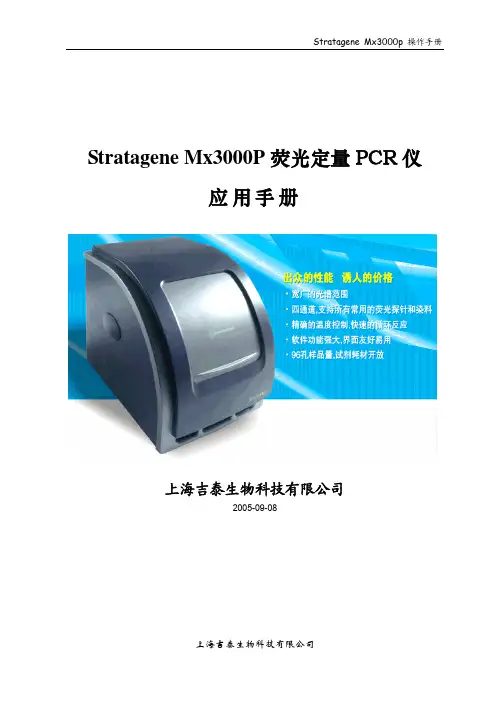

MSO/UPO3000CS系列数字荧光示波器数据手册REV42023.12⏹模拟通道带宽:500MHz,350MHz⏹模拟通道实时采样率2.5GSa/s,数字通道实时采样率1.25GSa/s(仅MSO)⏹输入阻抗1MΩ和50Ω⏹标配每通道70Mpts存储深度,单次或扫描模式最大存储深度250Mpts⏹波形捕获率最高1,000,000wfms/s⏹内置50MHz等性能双通道函数/任意波形发生器(仅MSO-S),支持实时加载示波器屏幕数据到AWG任意波输出⏹支持波特图环路测试分析功能⏹多达120,000帧的硬件实时波形不间断录制和分析功能,并支持USB存储设备导出⏹波形运算功能(加、减、乘、除、数字滤波、逻辑运算和高级运算)⏹1M点增强FFT,支持频率设置,瀑布图,检波设置和标记测量等⏹可自动测量36种波形参数⏹支持扫描时参数测量⏹Multi-Scopes2.0支持多通道独立触发荧光显示⏹多通道独立7位硬件频率计⏹DVM支持多通道独立交直流真有效值测量⏹丰富的触发功能:边沿,脉宽,视频,斜率,欠幅脉冲,超幅脉冲,延迟,超时,持续时间,建立保持、第N边沿和码型触发⏹区域触发功能,可用于捕获偶发信号和观察复杂信号等⏹协议触发和解码功能,选配RS232,I2C,SPI,CAN,CAN-FD,LIN,FlexRay⏹Ultra Phosphor2.0超级荧光显示效果,高达256级的灰度显示⏹8英寸800x480高清电容触摸,支持各种手势操作:点击,滑动,缩放,编辑,拖动等⏹丰富的外围接口:USB Host、USB Device、LAN、EXT Trig、AUX Out(Trig Out、Pass/Fail)输出、信号源输出接口(AWG)、VGA⏹支持U盘数据存储和U盘进行软件升级、一键拷屏等功能⏹支持即插即用USB设备,可通过USB设备与计算机通信⏹支持SCPI可编程仪器标准命令⏹支持WEB访问和控制MSO/UPO3000CS系列数字荧光示波器基于UNI-T独创的Ultra Phosphor2.0技术的一款多功能、高性能的示波器,实现了易用性、优异的技术指标及众多功能特性的完美结合,可帮助用户更快地完成测试工作。
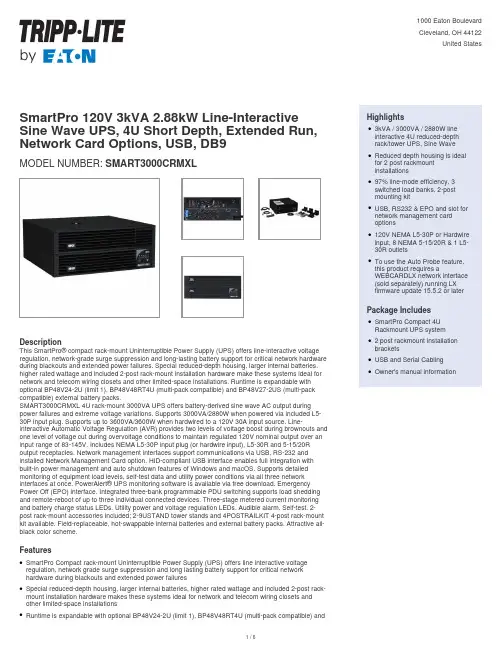
SmartPro 120V 3kVA 2.88kW Line-Interactive Sine Wave UPS, 4U Short Depth, Extended Run, Network Card Options, USB, DB9MODEL NUMBER:SMART3000CRMXLDescriptionThis SmartPro® compact rack-mount Uninterruptible Power Supply (UPS) offers line-interactive voltage regulation, network-grade surge suppression and long-lasting battery support for critical network hardware during blackouts and extended power failures. Special reduced-depth housing, larger internal batteries, higher rated wattage and included 2-post rack-mount installation hardware make these systems ideal for network and telecom wiring closets and other limited-space installations. Runtime is expandable with optional BP48V24-2U (limit 1), BP48V48RT4U (multi-pack compatible) and BP48V27-2US (multi-pack compatible) external battery packs.SMART3000CRMXL 4U rack-mount 3000VA UPS offers battery-derived sine wave AC output during power failures and extreme voltage variations. Supports 3000VA/2880W when powered via included L5-30P input plug. Supports up to 3600VA/3600W when hardwired to a 120V 30A input source. Line-interactive Automatic Voltage Regulation (AVR) provides two levels of voltage boost during brownouts and one level of voltage cut during overvoltage conditions to maintain regulated 120V nominal output over an input range of 83-145V. Includes NEMA L5-30P input plug (or hardwire input), L5-30R and 5-15/20R output receptacles. Network management interfaces support communications via USB, RS-232 and installed Network Management Card option. HID-compliant USB interface enables full integration with built-in power management and auto shutdown features of Windows and macOS. Supports detailed monitoring of equipment load levels, self-test data and utility power conditions via all three network interfaces at once. PowerAlert® UPS monitoring software is available via free download. Emergency Power Off (EPO) interface. Integrated three-bank programmable PDU switching supports load shedding and remote-reboot of up to three individual connected devices. Three-stage metered current monitoring and battery charge status LEDs. Utility power and voltage regulation LEDs. Audible alarm. Self-test. 2-post rack-mount accessories included; 2-9USTAND tower stands and 4POSTRAILKIT 4-post rack-mount kit available. Field-replaceable, hot-swappable internal batteries and external battery packs. Attractive all-black color scheme.FeaturesSmartPro Compact rack-mount Uninterruptible Power Supply (UPS) offers line interactive voltage regulation, network grade surge suppression and long lasting battery support for critical network hardware during blackouts and extended power failuresqSpecial reduced-depth housing, larger internal batteries, higher rated wattage and included 2-post rack-mount installation hardware makes these systems ideal for network and telecom wiring closets and other limited-space installationsqRuntime is expandable with optional BP48V24-2U (limit 1), BP48V48RT4U (multi-pack compatible) and q Highlights3kVA / 3000VA / 2880W lineinteractive 4U reduced-depthrack/tower UPS, Sine WaveqReduced depth housing is idealfor 2 post rackmountinstallationsq97% line-mode efficiency, 3switched load banks, 2-postmounting kitqUSB, RS232 & EPO and slot for network management cardoptionsq120V NEMA L5-30P or Hardwire input, 8 NEMA 5-15/20R & 1 L5-30R outletsqTo use the Auto Probe feature,this product requires aWEBCARDLX network interface (sold separately) running LXfirmware update 15.5.2 or later qPackage IncludesSmartPro Compact 4URackmount UPS systemq2 post rackmount installationbracketsqUSB and Serial CablingqOwner's manual informationqSpecificationsBP48V27-2US (multi-pack compatible) external battery packsSome external battery configurations require the use of External Battery Configuration Software (see manual)qIntelligent battery management system extends battery lifeq SMART3000CRMXL 4U rack-mount 3000VA/2880 watt UPS offers battery-derived sine wave AC output during power failures and extreme voltage variations qSupports loading up to 3600 watts when hardwiredq Line interactive Automatic Voltage Regulation (AVR) provides two levels of voltage boost during brownouts and one level of voltage cut during overvoltage conditions to maintain regulated 120V nominal output over an input range of 83-145VqIncludes NEMA L5-30P input plug (hardwire line cord installation supported), L5-30R and 5-15/20R output receptaclesqNetwork management interfaces support simultaneous communications via USB port, DB9 serial port and installed Network Management Card optionqCompatible with UPS management card options WEBCARDLX, SNMPWEBCARD and RELAYIOCARD q HID-compliant USB interface enables full integration with built-in power management and auto shutdown features of Windows and macOSq97% efficiency in line power mode offers substantially lower operating costs than lower efficiency UPS typesqSupports detailed monitoring of equipment load levels, self-test data and utility power conditions via all 3network interfaces at onceqUSB & Serial ports enable data-saving unattended shutdown when used with PowerAlert software,available via FREE download from /products/power-alert qEmergency Power Off (EPO) interfaceq Integrated 3-bank programmable PDU switching supports load shedding and remote-reboot of up to 3individual connected devicesq3-stage metered current monitoring and battery charge status LEDs; Utility power and voltage regulation LEDs; Audible alarm; Self-testq2-post rack-mount accessories included; 2-9USTAND tower stands and 4POSTRAILKIT 4-post rack-mount kit availableqField-replaceable, hot-swappable internal batteries and external battery packs q Attractive all-black color schemeq© 2023 Eaton. All Rights Reserved. Eaton is a registered trademark. All other trademarks are the property of their respective owners.。

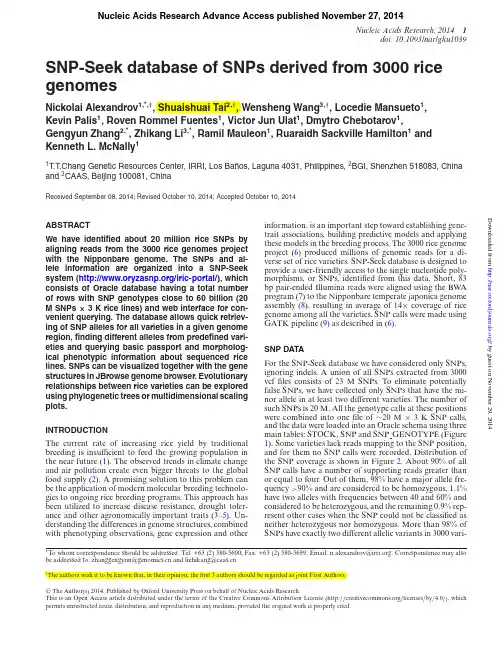
Nucleic Acids Research,20141doi:10.1093/nar/gku1039SNP-Seek database of SNPs derived from 3000rice genomesNickolai Alexandrov 1,*,†,Shuaishuai Tai 2,†,Wensheng Wang 3,†,Locedie Mansueto 1,Kevin Palis 1,Roven Rommel Fuentes 1,Victor Jun Ulat 1,Dmytro Chebotarov 1,Gengyun Zhang 2,*,Zhikang Li 3,*,Ramil Mauleon 1,Ruaraidh Sackville Hamilton 1and Kenneth L.McNally 11T .T .Chang Genetic Resources Center,IRRI,Los Ba˜nos,Laguna 4031,Philippines,2BGI,Shenzhen 518083,China and 3CAAS,Beijing 100081,ChinaReceived September 08,2014;Revised October 10,2014;Accepted October 10,2014ABSTRACTWe have identified about 20million rice SNPs by aligning reads from the 3000rice genomes project with the Nipponbare genome.The SNPs and al-lele information are organized into a SNP-Seek system (/iric-portal/),which consists of Oracle database having a total number of rows with SNP genotypes close to 60billion (20M SNPs ×3K rice lines)and web interface for con-venient querying.The database allows quick retriev-ing of SNP alleles for all varieties in a given genome region,finding different alleles from predefined vari-eties and querying basic passport and morpholog-ical phenotypic information about sequenced rice lines.SNPs can be visualized together with the gene structures in JBrowse genome browser.Evolutionary relationships between rice varieties can be explored using phylogenetic trees or multidimensional scaling plots.INTRODUCTIONThe current rate of increasing rice yield by traditional breeding is insufficient to feed the growing population in the near future (1).The observed trends in climate change and air pollution create even bigger threats to the global food supply (2).A promising solution to this problem can be the application of modern molecular breeding technolo-gies to ongoing rice breeding programs.This approach has been utilized to increase disease resistance,drought toler-ance and other agronomically important traits (3–5).Un-derstanding the differences in genome structures,combined with phenotyping observations,gene expression and otherinformation,is an important step toward establishing gene-trait associations,building predictive models and applying these models in the breeding process.The 3000rice genome project (6)produced millions of genomic reads for a di-verse set of rice varieties.SNP-Seek database is designed to provide a user-friendly access to the single nucleotide poly-morphisms,or SNPs,identified from this data.Short,83bp pair-ended Illumina reads were aligned using the BW A program (7)to the Nipponbare temperate japonica genome assembly (8),resulting in average of 14×coverage of rice genome among all the varieties.SNP calls were made using GATK pipeline (9)as described in (6).SNP DATAFor the SNP-Seek database we have considered only SNPs,ignoring indels.A union of all SNPs extracted from 3000vcf files consists of 23M SNPs.To eliminate potentially false SNPs,we have collected only SNPs that have the mi-nor allele in at least two different varieties.The number of such SNPs is 20M.All the genotype calls at these positions were combined into one file of ∼20M ×3K SNP calls,and the data were loaded into an Oracle schema using three main tables:STOCK,SNP and SNP GENOTYPE (Figure 1).Some varieties lack reads mapping to the SNP position,and for them no SNP calls were recorded.Distribution of the SNP coverage is shown in Figure 2.About 90%of all SNP calls have a number of supporting reads greater than or equal to four.Out of them,98%have a major allele fre-quency >90%and are considered to be homozygous,1.1%have two alleles with frequencies between 40and 60%and considered to be heterozygous,and the remaining 0.9%rep-resent other cases when the SNP could not be classified as neither heterozygous nor homozygous.More than 98%of SNPs have exactly two different allelic variants in 3000vari-*Towhom correspondence should be addressed.Tel:+63(2)580-5600;Fax:+63(2)580-5699;Email:n.alexandrov@.Correspondence may also be addressed to:zhanggengyun@ and lizhikang@†The authors wish it to be known that,in their opinion,the first 3authors should be regarded as joint First Authors.C The Author(s)2014.Published by Oxford University Press on behalf of Nucleic Acids Research.This is an Open Access article distributed under the terms of the Creative Commons Attribution License ( /licenses /by /4.0/),which permits unrestricted reuse,distribution,and reproduction in any medium,provided the original work is properly cited.Nucleic Acids Research Advance Access published November 27, 2014 by guest on November 29, 2014/Downloaded from2Nucleic Acids Research,2014Figure 1.Basic schema of the SNP-SeekdatabaseFigure 2.Distribution of SNP coverageeties,1.7%of SNPs have three variants and 0.02%of SNPs have all four nucleotides in different genomes mapped to that SNP position.There are 2.3×more transitions than transvertions in our database (Table 1).Not all SNPs have been called in all varieties.Actually,the distribution of the called SNPs among varieties is bi-modal,with one mode at about 18M SNP calls correspond-ing to japonica varieties which are close to the reference genome,and the second peak at about 14M correspond-ing to the other varieties (Figure 3).Figure 3.SNP distribution by varieties.The major peak shows that about 14M SNPs have been called in most varieties.The bimodal plot indicates that a fraction of SNPs are missing in some varieties,likely due to lack of mapped reads in variable regions.Table 1.Types of allele variants and their frequencies in rice SNPs Allele variants Frequency,%A /G +C /T 70A /C +G /T 15A /T 9C /G6by guest on November 29, 2014/Downloaded fromNucleic Acids Research,20143Figure4.Multidimensional scaling plot of the3000rice varieties.Ind1,ind2and ind3are three groups of indica rice,indx corresponds to other indica varieties,temp is temperate japonica,trop is tropical japonica,temp/trop and trop/temp are admixed temperate and tropical japonica varieties,japx is other japonica varieties,aus is aus,inax is admixed aus and indica,aro is aromatic and admix is all other unassigned varieties.GENOME ANNOTATION DATAWe used CHADO database schema(10)to store the Nip-ponbare reference genome and gene annotation,down-loaded from the MSU rice web site(http://rice.plantbiology. /)(8).To browse and visualize genes and SNPs in the rice genome,we integrated the JBrowse genome browser (11)as a feature of our site.PASSPORT AND MORPHOLOGICAL DATAMost of the3000varieties(and eventually all)are conserved in the International Rice genebank housed at IRRI(12). Passport and basic morphological data from the source ac-cession for the purified genetic stock are accessible via SNP-Seek.INTERFACESWe deployed interfaces to facilitate the following major types of queries:(i)for two varieties find all SNPs from a gene or genomic region that differentiate them;(ii)for a gene or genome region,show all SNP calls for all va-rieties(Supplementary Figure S1);(iii)find all sequenced varieties from a certain country or a subpopulation,whichcan be viewed as a phylogenetic tree,built using TreeCon-structor class from BioJava(13)and rendered using jsPhy-loSVG JavaScript library(14)(Supplementary Figure S2)oras a multidimensional scaling plots(Figure4).The resultsof SNP search can be viewed as a table exported to text files,or visualized in JBrowse.USE CASE EXAMPLE FOR QUERYING A REGION OF INTERESTWe used Rice SNP-Seek database to quickly examine the diversity of the entire panel at a particular region of inter-est.We chose the sd-1gene as test case due to its scientific importance in rice breeding.This semi-dwarf locus,causinga semi-dwarf stature of rice,was discovered by three differ-ent research groups to be a spontaneous mutation of GA20-oxidase(formally named sd-1gene),originating fromthe Taiwanese indica variety Deo-woo-gen.Its incorpora-tion into IR8and other varieties by rice breeding programs spurred the First Green Revolution in rice production inthe late1960s(15).Sd-1is annotated in the Nipponbare genome by Michigan State University’s Rice Genome An-notation Project as LOC Os01g66100,on chromosome1by guest on November 29, 2014/Downloaded from4Nucleic Acids Research,2014Figure 5.Jbrowse view of the SNP genotypes within the sd-1gene (each variety is one row).Red blocks indicate polymorphism of the variety against Nipponbare.Shared SNP blocks are seen as vertical columns in red.The blue rectangle box in the bottom contains varieties that do not have these blocks.from position 38382382to 38385504base pairs.On the home page of SNP-Seek,the <Genotype >module was opened and the coordinates of sd-1were used to define the region to retrieve all SNPs,with <All Varieties >checked to select from all the varieties.Clicking on <Search >but-ton resulted in the identification of 80SNP positions (Sup-plementary Figure S1).An overall view of the SNP posi-tions in the polymorphic panel shows at least eight distinct SNP blocks (Figure 5).In this particular panel group of mostly temperate japonica,two distinct SNP blocks can be seen as shared (Figure 5).Variety information can be ob-tained by typing the name of the varieties you see on the genome browser into the <Variety name >field of the Vari-ety module.This use case is one of the examples detailed in the <Help >module.CONCLUSIONWe have organized the largest collection of rice SNPs into the database data structures for convenient querying and provided user-friendly interfaces to find SNPs in certaingenome regions.We have demonstrated that about 60bil-lion data points can be loaded into an Oracle database and queried with a reasonable (quick)response times.Most of the varieties in SNP-Seek database have passport and ba-sic phenotypic data inherited from their source accession enabling genome-wide or gene-specific tests of association.The database is quickly developing and will be expanding in the near future to include short indels,larger structural variations,SNPs calls using other rice reference genomes.SUPPLEMENTARY DATASupplementary Data are available at NAR Online.ACKNOWLEDGEMENTSWe would like to thank the IRRI ITS team (especially Ro-gelio Alvarez and Denis Diaz)and Rolando Santos Jr for the support in operation and administration of the database and web application servers,and Frances Borja for her help in interface design.by guest on November 29, 2014/Downloaded fromNucleic Acids Research,20145FUNDINGThe database is being supported by the Global Rice Science Partnership(GRiSP),the Bill and Melinda Gates Foundation(GD1393),International S&T Cooperation Program of China(2012DFB32280)and the Peacock Team Award to ZLI from the Shenzhen Municipal government. Conflict of interest statement.None declared. REFERENCES1.Ray,D.K.,Mueller,N.D.,West,P.C.and Foley,J.A.(2013)Yield trendsare insufficient to double global crop production by2050.PloS One, 8,e66428.2.Tai,A.P.K.,Martin,M.V.and Heald,C.L.(2014)Threat to futureglobal food security from climate change and ozone air pollution.Nat.Clim.Change,4,817–821.3.Fahad,S.,Nie,L.,Khan,F.A.,Chen,Y.,Hussain,S.,Wu,C.,Xiong,D.,Jing,W.,Saud,S.,Khan,F.A.et al.(2014)Disease resistance in riceand the role of molecular breeding in protecting rice crops againstdiseases.Biotechnol.Lett.,36,1407–1420.4.Hu,H.and Xiong,L.(2014)Genetic engineering and breeding ofdrought-resistant crops.Ann.Rev.Plant Biol.,65,715–741.5.Gao,Z.Y.,Zhao,S.C.,He,W.M.,Guo,L.B.,Peng,Y.L.,Wang,J.J.,Guo,X.S.,Zhang,X.M.,Rao,Y.C.,Zhang,C.et al.(2013)Dissecting yield-associated loci in super hybrid rice by resequencingrecombinant inbred lines and improving parental genome sequences.Proc.Natl.Acad.Sci.U.S.A.,110,14492–14497.6.3K R.G.P.(2014)The3,000rice genomes project.Gigascience,3,7.7.Li,H.and Durbin,R.(2009)Fast and accurate short read alignmentwith Burrows-Wheeler transform.Bioinformatics,25,1754–1760.8.Kawahara,Y.,de la Bastide,M.,Hamilton,J.P.,Kanamori,H.,McCombie,W.R.,Ouyang,S.,Schwartz,D.C.,Tanaka,T.,Wu,J.,Zhou,S.et al.(2013)Improvement of the Oryza sativa Nipponbarereference genome using next generation sequence and optical mapdata.Rice,6,4.9.McKenna,A.,Hanna,M.,Banks,E.,Sivachenko,A.,Cibulskis,K.,Kernytsky,A.,Garimella,K.,Altshuler,D.,Gabriel,S.,Daly,M.et al.(2010)The Genome Analysis Toolkit:a MapReduce framework foranalyzing next-generation DNA sequencing data.Genome Res.,20,1297–1303.10.Mungall,C.J.,Emmert,D.B.and FlyBase,C.(2007)A Chado casestudy:an ontology-based modular schema for representinggenome-associated biological information.Bioinformatics,23,i337–i346.11.Skinner,M.E.,Uzilov,A.V.,Stein,L.D.,Mungall,C.J.andHolmes,I.H.(2009)JBrowse:a next-generation genome browser.Genome Res.,19,1630–1638.12.Jackson,M.T.(1997)Conservation of rice genetic resources:the roleof the International Rice Genebank at IRRI.Plant Mol.Biol.,35,61–67.13.Prlic,A.,Yates,A.,Bliven,S.E.,Rose,P.W.,Jacobsen,J.,Troshin,P.V.,Chapman,M.,Gao,J.,Koh,C.H.,Foisy,S.et al.(2012)BioJava:anopen-source framework for bioinformatics in2012.Bioinformatics,28,2693–2695.14.Smits,S.A.and Ouverney,C.C.(2010)jsPhyloSVG:a javascriptlibrary for visualizing interactive and vector-based phylogenetic treeson the web.PloS One,5,e12267.15.Hedden,P.(2003)The genes of the Green Revolution.Trends Genet.,19,5–9.by guest on November 29, 2014/Downloaded from。
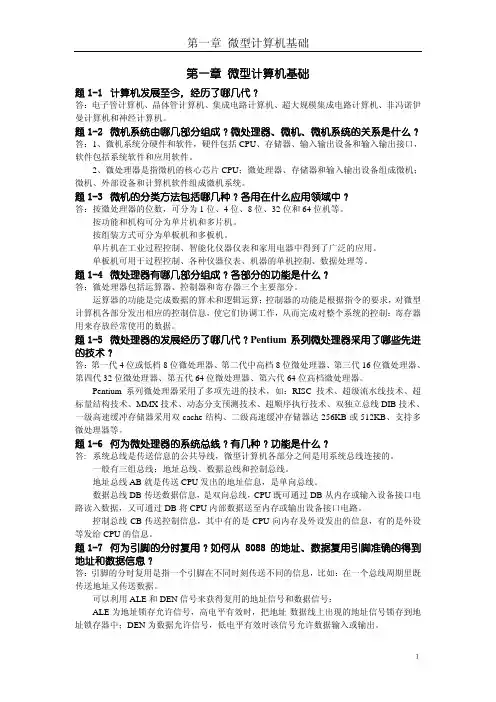
第一章 微型计算机基础题1-1 计算机发展至今,经历了哪几代?答:电子管计算机、晶体管计算机、集成电路计算机、超大规模集成电路计算机、非冯诺伊曼计算机和神经计算机。
题1-2 微机系统由哪几部分组成?微处理器、微机、微机系统的关系是什么? 答:1、微机系统分硬件和软件,硬件包括CPU、存储器、输入输出设备和输入输出接口,软件包括系统软件和应用软件。
2、微处理器是指微机的核心芯片CPU;微处理器、存储器和输入输出设备组成微机;微机、外部设备和计算机软件组成微机系统。
题1-3 微机的分类方法包括哪几种?各用在什么应用领域中?答:按微处理器的位数,可分为1位、4位、8位、32位和64位机等。
按功能和机构可分为单片机和多片机。
按组装方式可分为单板机和多板机。
单片机在工业过程控制、智能化仪器仪表和家用电器中得到了广泛的应用。
单板机可用于过程控制、各种仪器仪表、机器的单机控制、数据处理等。
题1-4 微处理器有哪几部分组成?各部分的功能是什么?答:微处理器包括运算器、控制器和寄存器三个主要部分。
运算器的功能是完成数据的算术和逻辑运算;控制器的功能是根据指令的要求,对微型计算机各部分发出相应的控制信息,使它们协调工作,从而完成对整个系统的控制;寄存器用来存放经常使用的数据。
题1-5 微处理器的发展经历了哪几代?Pentium系列微处理器采用了哪些先进的技术?答:第一代4位或低档8位微处理器、第二代中高档8位微处理器、第三代16位微处理器、第四代32位微处理器、第五代64位微处理器、第六代64位高档微处理器。
Pentium系列微处理器采用了多项先进的技术,如:RISC技术、超级流水线技术、超标量结构技术、MMX技术、动态分支预测技术、超顺序执行技术、双独立总线DIB技术、一级高速缓冲存储器采用双cache结构、二级高速缓冲存储器达256KB或512KB、支持多微处理器等。
题1-6 何为微处理器的系统总线?有几种?功能是什么?答: 系统总线是传送信息的公共导线,微型计算机各部分之间是用系统总线连接的。
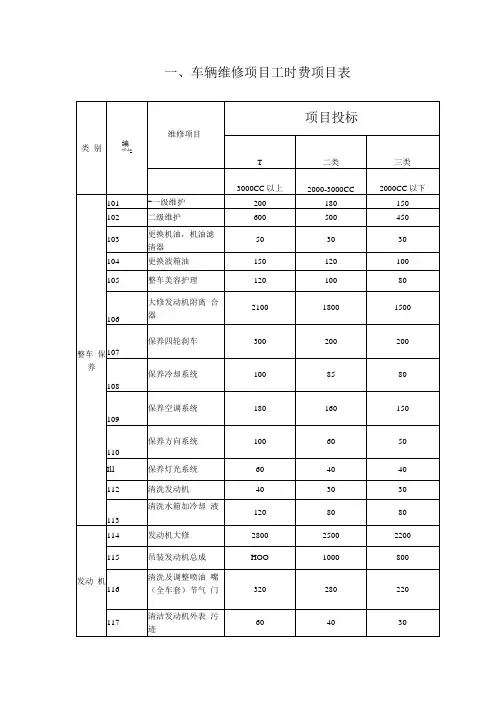
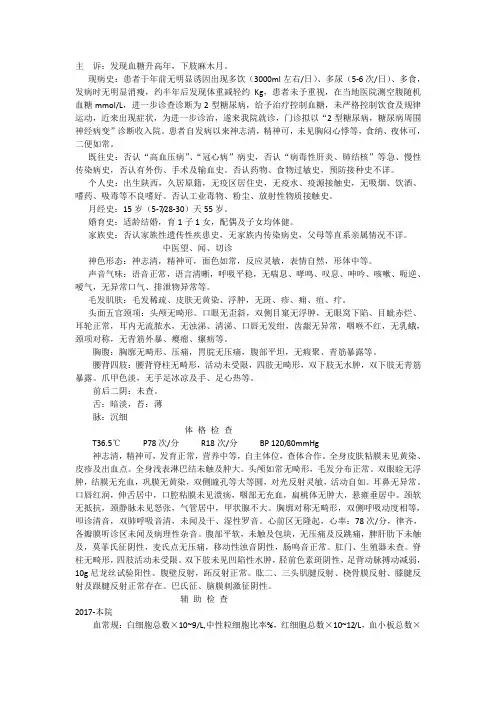
主诉:发现血糖升高年,下肢麻木月。
现病史:患者于年前无明显诱因出现多饮(3000ml左右/日)、多尿(5-6次/日)、多食,发病时无明显消瘦,约半年后发现体重减轻约Kg,患者未予重视,在当地医院测空腹随机血糖mmol/L,进一步诊查诊断为2型糖尿病,给予治疗控制血糖,未严格控制饮食及规律运动,近来出现症状,为进一步诊治,遂来我院就诊,门诊拟以“2型糖尿病,糖尿病周围神经病变”诊断收入院。
患者自发病以来神志清,精神可,未见胸闷心悸等,食纳、夜休可,二便如常。
既往史:否认“高血压病”、“冠心病”病史,否认“病毒性肝炎、肺结核”等急、慢性传染病史,否认有外伤、手术及输血史。
否认药物、食物过敏史,预防接种史不详。
个人史:出生陕西,久居原籍,无疫区居住史,无疫水、疫源接触史,无吸烟、饮酒、嗜药、吸毒等不良嗜好。
否认工业毒物、粉尘、放射性物质接触史。
月经史:15岁(5-7/28-30)天55岁。
婚育史:适龄结婚,育1子1女,配偶及子女均体健。
家族史:否认家族性遗传性疾患史,无家族内传染病史,父母等直系亲属情况不详。
中医望、闻、切诊神色形态:神志清,精神可,面色如常,反应灵敏,表情自然,形体中等。
声音气味:语音正常,语言清晰,呼吸平稳,无喘息、哮鸣、叹息、呻吟、咳嗽、呃逆、嗳气,无异常口气、排泄物异常等。
毛发肌肤:毛发稀疏、皮肤无黄染、浮肿,无斑、疹、痈、疽、疔。
头面五官颈项:头颅无畸形。
口眼无歪斜,双侧目窠无浮肿,无眼窝下陷、目眦赤烂、耳轮正常,耳内无流脓水,无浊涕、清涕、口唇无发绀,齿龈无异常,咽喉不红,无乳蛾,颈项对称,无青筋外暴、瘿瘤、瘰疬等。
胸腹:胸廓无畸形、压痛,胃脘无压痛,腹部平坦,无瘕聚、青筋暴露等。
腰背四肢:腰背脊柱无畸形,活动未受限,四肢无畸形,双下肢无水肿,双下肢无青筋暴露。
爪甲色淡,无手足冰凉及手、足心热等。
前后二阴:未查。
舌:暗淡,苔:薄脉:沉细体格检查T36.5℃P78次/分R18次/分BP 120/80mmHg神志清,精神可,发育正常,营养中等,自主体位,查体合作。
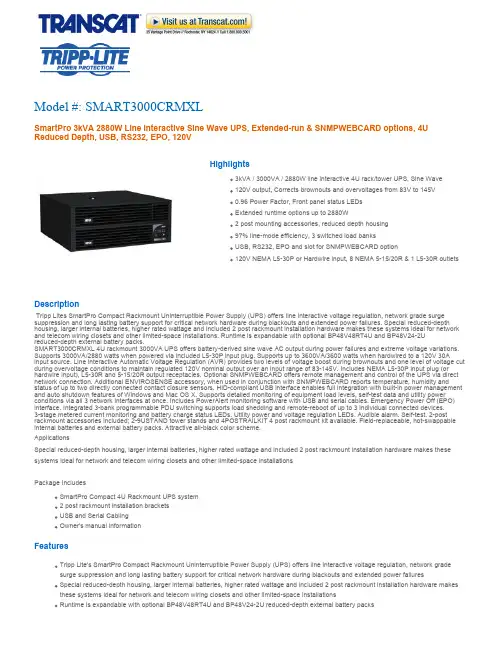
UPS Input cord length(ft.)10 ft.UPS Input cord length(m)3.05RecommendedElectrical Service120V 30AVoltage compatibility(VAC)120BATTERYFull load runtime(minutes)7.5 min. (2880w)Half load runtime(minutes)19 min. (1440w)External battery packcompatibilityBP48V24-2U (limit 1); BP48V48RT4U (multi-pack compatible)DC system voltage(VDC)48Battery recharge rate(included batteries)Less than 7.2 hours from 10% to 90%Replacement batterycartridge (internalUPS batteryreplacement)RBC54 (quantity 2)Battery Access Battery access door allows hot swap battery replacement without powering connected equipment off VOLTAGE REGULATIONVoltage regulation description Automatic Voltage Regulation (AVR) circuits maintain clean, regulated computer-grade 120V nominal output, without using battery power, during brownouts to 83V and overvoltages to 145VOvervoltage correction Input voltages between 127 and 145V AC are reduced by 12%UndervoltagecorrectionInput voltages between 96 and 108 are boosted by 12%Severe undervoltagecorrectionInput voltages between 83 and 95 are boosted by 24%LEDS ALARMS & SWITCHESLED Indicators 5 LEDs indicate line power, battery power, overload, voltage regulation and battery low/replace statusAlarms 3 function audible alarm indicates power failure conditions (4 short beeps every 10 seconds), overload (continuous short beeps) and low battery (continuous tone)Switches Yes, includes 2 front panel mounted push-button switches for system enable, self-test and alarm cancel functions.Back panel includes battery charge level switch for internal or external battery configurationsSURGE / NOISE SUPPRESSIONUPS AC suppressionjoule rating570 joulesEMI / RFI AC noisesuppressionYesAC suppressionresponse timeInstantaneousPHYSICALInstallation formfactors supported withincluded accessories2 post 19 inch rackmount (mounting rail kit included)Installation formfactors supported withoptional accessories4 post rackmount (4POSTRAILKIT); Tower (2-9USTAND)Primary form factor RackmountUPS / Power Moduledimensions in primaryform factor (height xwidth x depth / inches)7 x 17.3 x 16.8UPS / Power Moduledimensions in primaryform factor (height xwidth x depth / cm)17.8 x 43.9 x 42.7Installed wholesystem total rackspace height (rackspaces)4UUPS / Power Moduleweight (lbs)102UPS / Power Moduleweight (kg)46.3UPS Shippingdimensions (height xwidth x depth / inches)13.2 x 23.6 x 22.8UPS Shippingdimensions (height xwidth x depth / cm)33.5 x 59.9 x 57.9Shipping weight (lbs)124Shipping weight (kg)56.3UPS housing material SteelCooling method FanENVIRONMENTALOperatingTemperature Range+32 to +104 degrees Fahrenheit / 0 to +40 degrees CelsiusStorage TemperatureRange+5 to +122 degrees Fahrenheit / -15 to +50 degrees CelsiusRelative Humidity0-95%, non-condensingAC mode BTU / hr.(full load)408Battery mode BTU /hr. (full load)2149.5COMMUNICATIONSCommunicationsinterfaceUSB (HID enabled); DB9 Serial; EPO (emergency power off); Slot for SNMP/Web interfaceWatchDog compatibility Yes, compatible with Tripp Lite's Watchdog system service to restore operation to locked equipment through soft reboot of application / OS or hard power off/on reboot of connected equipment ideal for unattended kiosk applicationsEPO port Includes RJ11 EPO (emergency power off) port and interconnection cableSNMP compatibility Yes, includes slot for optional SNMPWEBCARD accessory (#SNMPWEBCARD)Yes, includes PowerAlert software CD-ROM and complete cablingSoftware and cablingincludedLINE / BATTERY TRANSFERTransfer time 5 ms. (typical)Low voltage transfer83to battery power(setpoint)145High voltage transferto battery power(setpoint)SPECIAL FEATURESCold Start (startup inCold-start operation supportedbattery mode during apower failure)Appearance Attractive black rackmount housing, optional use 2U black front bezel included to enable black color appearance CERTIFICATIONSCertifications Tested to UL1778 (USA), CSA (Canada), NOM (Mexico), Class A (Emissions)WARRANTY2-year warranty, 3 year with registration. Note: registration is required for 3-year warranty.Product WarrantyPeriod (Worldwide)$250,000 Ultimate Lifetime InsuranceConnected EquipmentInsurance (U.S.,Canada & Puerto Rico)Related ItemsOptional ProductsRelated Model Description Qty. BP48V24-2U BP48V242U - External Battery Pack for UPS System 1 BP48V48RT4U Shallow-Depth External Battery Pack For UPS Systems 11 ENVIROSENSE Monitors temperature, humidity and contact-closure inputs. (Requires SNMPWEBCARDor switched PDU.)PDUMH30NET Switched, Metered PDU with Remote Monitoring - 2U Rackmount Power Distribution Unit1for Networks with Individually Switchable Outlets, Current Metering, Remote Monitoringand Control1 PDUMV30Metered 0U Vertical Rack PDU - Metered Power Distribution Unit for NetworkApplicationsPDUMV30NET Switched, Metered PDU with Remote Monitoring - 0U Vertical Rackmount Power1Distribution Unit for Networks with Individually Switchable Outlets, Current Metering,Remote Monitoring and Control1 PDU2430Basic PDU / Power Distribution Unit - Safe, reliable power distribution for criticalnetworking equipmentSNMPWEBCARD For remote monitoring and control via SNMP, Web, or Telnet. 1 WEXT5-2200-30005-Year Extended Warranty - For Smart Line-Interactive and Online Tower or Rack1models, 2200-3000VA or less2-9USTAND Enables Tower Placement of Rackmount UPS Systems 1。

12年春季学期微机接口技术复习题供电信学院各专业复习参考1、假设(CS)=3000H, (DS)=4000H, (ES)=2000H, (SS)=5000H, (AX)=2060H, (BX)=3000H, (CX)=5, (DX)=0, (SI)=2060H, (DI)=3000H, (43000H)=0A006H, (23000H)=0B116H, (33000H)=0F802H, (25060)=00B0H,下列各条指令为单独执行指令,前后无关系,请回到括号中的问题。
(1)SBB AX,BX完成的是(带借位减法)操作,AX=()(2) CMP AX,WORD PTR[SI+0FA0H]完成的是(两个数的比较)操作,AX=()(3) MUL BYTE PTR[BX]完成的是(两个数的乘法)操作,AX=()(4) DIV BH完成的是(两个数的除法)操作,AX=()(5) SAR AX,CL完成的是()操作,AX=()2、假设(DS)=2000H,(ES)=3000H,(SS)=4000H,(SP)=100H,(BX)=200H,(SI)=0001,(DI)=0002,(BP)=256,字变量ARRAY偏移地址为0050H,(20250H)=1234H,(40100H)=00A0H,(40102H)=2200H。
执行下列程序段并分析指令执行后的结果,(注意:不是单条指令),按给出的要求填空回答问题:(1)MOV AX,[BP][SI]源操作数物理地址= H ,指令执行后(AX)= H(2)POP AX源操作数物理地址= H ,指令执行后(AX)= H(3)MOV AL,[BX]源操作数有效地址= H,指令执行后(AX)= H(4)LEA DI,ARRAY源操作数的寻址方式是,指令执行后(DI)= H(5)JMP BX指令执行后(IP)= H(6)INC BX源操作数的寻址方式是3、指出下列指令的错误,(要求说明错误的原因,并给出正确的写法)(1) MOV AH, BX(2) MOV [SI], [BX](3) MOV AX, [SI][DI](4) MOV BYTE PTR[BX],1000H(5) MOV DS,BP4、若给定AX和BX的值如下,(1)(AX)=14C8H,(BX)=808DH(2)(AX)=D022H,(BX)=9F70H(3)(AX)=148DH,(BX)=808DH(4)(AX)=9F22H,(BX)=9F20H已知下列程序段,按无符号数计算,说明程序的转向。
一、奖助学金
1.学校设立的奖学金:分为优秀学生奖学金和单项奖学金两大类:
(1)优秀学生奖学金分为:特等、一、二、三等奖学金,获奖比例分别为:特等奖学金,全校10名,每人每次5000元;一、二、三等奖学金比例,占参加测评学生的6%、13%、23%,奖学金额度分别为2000元、1000元、500元;
(2)单项奖学金包括:1)科技创新奖学金、2)文体活动优秀奖学金、3)社会实践奖学金、4)优秀学生干部奖学金、5)优秀青年志愿者奖学金、6)学习进步奖学金、7)励志奖学金等。
2.国家、企业、社会组织和个人奖学金:
分为优秀学生奖学金、励志奖学金、定向就业奖学金三类。
具体的奖助学金名称和标准见表2。
2010年全校42%本科生获奖学金,平均每人获奖学金2400多元,全校33%的本科生获得助学金,平均每人助学金2000多元。
另外,各院系还设有多项奖助学金。
二、国家助学贷款
根据教育部、财政部、中国人民银行、国家税务总局共同下发的有关文件规定,我校已积极开展助学贷款工作,用以帮助经济困难的学生支付在校期间的学费及其部分生活费,以保证其顺利完成学业。
3000字学习总结3000字学习总结【篇一:学习总结(3000字)】培训总结这三个月的时间里,在国网公司宜昌管理处进行理论学习和宜都换流站进行设备认知的学习总结。
一、培训内容本次培训的主要目的是通过多媒体培训系统学习和换流站现场学习相结合的方式熟悉换流站的相关设备,为以后能够在拉萨换流站工作做好准备。
通过本次培训学习,我对换流站一次设备有了比较全面的认识和熟悉,并掌握换流站运行方式等基础知识。
二、学习收获(一)电力安全工作规程培训开始是学习的由国家电网公司颁布的《电力安全工作规程》。
在这期间培训老师还放映了违章电力安全工作规程造成的后果的视频,一个个血的教训。
“安全第一”是电力企业永恒的主题。
电力企业安全管理、安全保障、安全监督体系严谨完备,但在实际工作中,百密一疏,仍存在事故隐患,甚至发生违章事故。
究其原因,大多因为班组成员违反《电力安全工作规程》所致。
使我感到作为一个电力工作者,我们手中握着的不仅是我们自己,还有队友乃至广大人民的生命财产安全,任何一个小小的疏忽或失误,都可能对人身、电网和社会生产生活造成巨大的影响。
因此,为了保证安全,必须从身边的点滴小事做起,培养起严明的纪律和严谨的作风,工作时严格按照《电力安全工作规程》执行。
同时,也使我深刻认识到应该认真学习电力专业知识,夯实工作基本技能,为以后更好地走上岗位打下坚实的基础。
同时从全局方面了解了我们将要从事的电力工作,树立了全局观念,让我深刻的领悟到,无论我们在哪个岗位上,都应该兢兢业业的工作。
任何一个地方出现错误操作都有可能对其他电网部分产生影响。
(二)换流站基本介绍换流站的主要功能是实现交直流的转换从而实现直流远距离输电,按照转换过程分为整流站和逆变站,其中整流站将交流转换为直流,逆变站将直流转换为交流。
直流输电的特点:(1)输送容量大;(2)送电距离远;(3)输送功率的大小和方向可快速调节;(4)直流输电系统的接入不会增加原有电力系统的短路电流容量,也不会受系统稳定极限的控制;(5)换流站的一个极发生故障停运后,另一个极能继续运行,保持输送功率或减小输送功率的损失。
一、第一部分数制、编码及计算机结构1.十进制数11.375转换为二进制数为_1011.011_____;二进制数1101101转换为十进制数为______。
4 二进制数1101.101转化成十进制数是13.6255 十六进制64.CH转化成十进制数是100.756 十进制数112.25转换成二进制数是1110000.01B7 将十进制数301.6875转换成等值的十六进制数为12D.B8 将二进制数110100110.101101B转化成十六进制数为1A6.B49 将十六进制数2A8F。
6DH转换为二进制数为10101010001111.01101101B26.十六进制数6B.CH转换为十进制数为107.75______;49的BCD编码是01001001(压缩的BCD码)。
十进制数234.15的BC D码表示为001000110100.00010101将BC D码(00010001.00100101)转化成二进制数1011.01.将二进制数01000111转换成BC D码011100015.A=-113D,则[A]补==10001111B14.A=+0110101,B=-0110101,[A+B]补=_00000000_____。
20.[A]补=10011101;[B]补=01010000;[A+B]补=11101101______,则运算结果的标位SF=__1__,OF=_0___。
25.A=-84,则[A]反=_10101011_____,[A]补=_10101100_____。
18.信息码为0110100,则奇校验码为__00110100__________。
22.信息码为0110100,则偶校验码为___10110100_________。
57.位(bi t)是存储器中存储信息的最小单位,称为_位____。
两个带符号数相加或者相减时,若C7⊕C6=1 则结果产生溢出。
三八译码器的使能端G1 G2A G2B 输入信号时1 0 0 ,译码器有效.译码输入端CBA输入信号000 时,Y0 有效译码输入端CBA输入信号010 时, Y2 有效(8086CPU基本结构)15. 从CPU的NMI引脚产生的中断叫做非屏蔽中断,它的响应不受IF标志___的影响。
BP-3000打印机培训WELCOME
BP-3000打印机培训打印机基本工作原理
打印机的参数设置
机械结构及原理
主控板工作原理
电源工作原理
故障检修流程
整机总体框图打印机械
电
脑主机
控制器
(分硬件
和软件)
开
关
电
源
操作面板
AC
电
源
开始
打印机初始化面板按键处理
数据预处理
数据接收发送
字打车印电击机针运印行
字
组织打印输出缓冲区
走纸电机运行
满足打印?完成?
工作流程
BACK
MENU
INTERFACE(接口)EMULATION(仿真)OLIVETTI OKI......
......
TYPE(型号)BAUDRATE(波特率)DATABITS(数据位)......
......
CENTRONICS(并口)RS232(串口)
菜单结构(树形结构)
菜单结构(树形结构)
MENU
Interface
Configuration
Epson
Proprinter XL24
......
......
Single mode Interface mode Dual mode Sett ings
Olivetti Emul. type1Emul. type2Low
noise ......
......
Interface mode: single,dual manual,dual automatic
Single mode: centronics,RS232/1,RS232/2,usb Dual mode: dual manual,dual automaitc Settings: RS232, USB ,Centronics
BACK 参数设置时按键的作用
•确认键:进入下一级菜单或接受当前所显示的参数值。
•用户1:显示在同一级菜单中前一项的参数值或菜单选项。
•用户2:显示在同一级菜单中后一项的参数值或菜单选项。
•停止键:退到上一级菜单或在接受了参数值后退出液晶显示的ACCEPTED状态。
可参考下图
停止
用户1用户2
确认
构成简介
打印机机械外壳打印机
控制单元
走纸机构纠偏机构打印机构
色带驱动机构
几种传感器
控制面板控制主板
电源板
可选接口卡
字车机构
字车机构
色带驱动机构
走纸机构
纠偏机构
纠偏机构
光栅定位传感器
上盖传感器
传感器
传感器
一、检纸传感器
二、顶纠偏传感器
三、右纠偏传感器
传感器
BACK 控制轴传感器,检测控制轴位置
控制单元电路
一、门阵二、中断处理器三、CPU
主板结构图
电机驱动电路
上图中,从左到右分别是:字车、纠偏、走纸电机驱动
主板结构图
打印头针驱动电路
主板结构图
并口电路
主板结构图
BACK
RAM 电路
一、字库二、监控三、RAM
主板结构图
电源框图
输入
滤波电路高压整流
滤波高
频
变
换
PWM
控制电路
稳压控制
过压过流
保护
输出40V
整流滤波
电源较复杂,可看成两个开关电源(5V,40V)
电源框图
输入
滤波电路高压整流
滤波高
频
变
换
PWM
控制电路稳压控制
过压过流
保护
输出5V
整流滤波
BACK
输出正负12V
7812/7912
COVER OPEN
上盖关闭?
关闭上盖
上盖传感器?
更换传感器
Y
Y
检查是否断线等
TRANSPORT ERROR
主板安装到位?
控制电机?
电机驱动模块?
控制轴传感器?
Y
Y
Y
重新安装主板
更换传感器
重插或更换电机
更换驱动模块
检查断线
Y
CARRIER ERROR
字车机构?
字车电机?
电机驱动模块?
光栅传感器?
Y
Y
Y
按下或重装字车机构
更换传感器
重插或更换电机
更换驱动模块
检查断线
Y
PAPER JAM
机内无纸屑?
光纤?检纸传感器组?Y
Y
Y
清理纸屑灰尘等
更换传感器组件
重插或更换光纤
检查断线
HEAD HOT
打印头温度正常?
打印头电缆?温度传感器好?Y
Y
Y
关机散热
更换打印头线圈
重插或更换电缆
检查断线
谢谢。